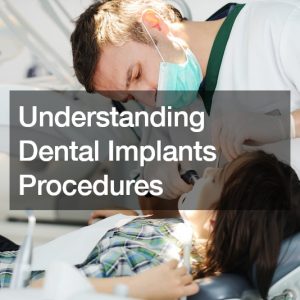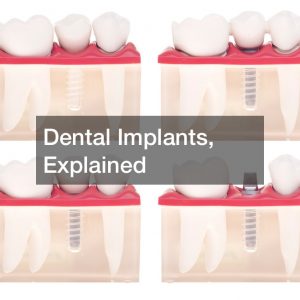Cosmetic dental implant procedures are becoming increasingly popular among patients looking to improve the appearance of their teeth. Dental implants are a permanent and effective solution for missing, damaged, or decayed teeth, and can be customized to match the natural color and shape of a patient’s existing teeth. They are also highly durable and can last a lifetime with proper care and maintenance.
Why Choose Cosmetic Dental Implant Procedures?
There are several reasons why cosmetic dental implant procedures are so popular among patients. One of the main reasons is the natural appearance of dental implants. Unlike traditional dentures or bridges, which can often look fake or artificial, dental implants are designed to blend in seamlessly with a patient’s existing teeth. This can greatly improve the patient’s smile and boost their confidence.
Another reason why cosmetic dental implant procedures are so popular is that they offer a long-term solution to tooth loss or damage. Dental implants are designed to be permanent, and with proper care and maintenance, they can last a lifetime. This can save patients the time and expense of having to replace dentures or bridges every few years.
In addition to their natural appearance and long-term durability, cosmetic dental implant procedures also offer functional benefits. They can help to restore a patient’s ability to speak and eat normally, as well as improve their overall oral health. When teeth are missing or damaged, the surrounding teeth can shift, leading to problems with chewing and speaking. Dental implants can help to stabilize the teeth and jaw, improving the patient’s overall dental function.
Finding a qualified and experienced dentist to perform cosmetic dental implant procedures is important for ensuring a successful outcome. Patients can ask their family dentists for recommendations, or search online for dental care services in their area. It is also a good idea to research the credentials and experience of any potential dentist before making a decision.

Understanding These Procedures
Cosmetic dental implant procedures, including dental implants, can be expensive, and it is important for patients to carefully consider their options and budget before making a decision. Many dental insurance plans do not cover cosmetic procedures, so patients may need to pay for the treatment out of pocket. However, for many patients, the benefits of dental implants outweigh the cost.
Cosmetic dental implant procedures are a popular choice among patients looking to improve the appearance of their teeth. They offer a natural appearance, long-term durability, and functional benefits, making them a highly effective solution for missing, damaged, or decayed teeth. It is important for patients to research and choose a qualified and experienced dentist to perform the procedure, as well as carefully consider their budget and options. Overall, dental implants can greatly improve a patient’s smile and oral health and are a worthwhile investment in dental care.
Common Dental Treatments
Cosmetic dental implant procedures are just one aspect of the larger field of cosmetic dentistry, which encompasses a range of treatments designed to improve the appearance of a patient’s teeth and smile. Some other popular cosmetic dental treatments include teeth whitening, veneers, and orthodontics.
Teeth whitening is a common procedure that uses bleaching agents to remove stains and discoloration from the surface of the teeth. It is a quick and relatively affordable way to improve the appearance of the teeth and can be done in a dental office or at home using over-the-counter products.
Veneers are thin, custom-made shells that are attached to the front of the teeth. They are used to cover up imperfections such as chips, cracks, gaps, or discoloration, and can greatly improve the appearance of the teeth. Veneers are made of porcelain or composite resin and are matched to the color of the patient’s existing teeth.
Orthodontics is the branch of dentistry that focuses on the alignment and straightening of the teeth and jaws. Orthodontic treatments such as braces and clear aligners can be used to correct misaligned teeth and improve the overall appearance of the smile.

Benefits
In addition to the cosmetic benefits, many of these treatments can also offer functional benefits. For example, straightening the teeth can improve the patient’s ability to chew and speak, and filling in gaps between the teeth can help to prevent dental problems such as cavities and gum disease.
While cosmetic dental treatments can greatly improve the appearance of the teeth and smile, it is important for patients to maintain good oral hygiene and visit their dentists regularly for checkups and cleanings. This can help to prevent dental problems and ensure that any cosmetic treatments are long-lasting.
It is also important for patients to carefully research and choose a qualified and experienced dentist for their cosmetic dental treatments. The field of cosmetic dentistry is largely unregulated, and it is important for patients to be aware of this when seeking treatment. Patients should ask about the dentist’s training, experience, and credentials, and should feel comfortable asking questions and discussing any concerns they may have.
Resources
There are many resources available to help patients find a qualified and experienced dentist for their cosmetic dental treatments. Patients can ask their family dentists for recommendations, or search online for dental care services in their area. Many dental associations and professional organizations also have directories of qualified dentists and can be a good resource for finding a reputable and experienced dentist.
Cosmetic dental implant procedures are just one aspect of the larger field of cosmetic dentistry, which encompasses a range of treatments designed to improve the appearance of the teeth and smile. Other popular treatments include teeth whitening, veneers, and orthodontics. It is important for patients to maintain good oral hygiene and visit their dentists regularly for checkups and cleanings, and carefully research and choose a qualified and experienced dentist for their cosmetic dental treatments. With the right care and attention, cosmetic dental treatments can greatly improve the appearance of the teeth and smile, and help to maintain overall oral health.

Understanding Risks
When considering cosmetic dental treatments such as dental implants, it is important for patients to be aware of the potential risks and complications involved. While dental implants are generally a safe and effective treatment option, there is a small risk of complications occurring. Some potential risks and complications of dental implants include:
Infection: One of the most common complications of dental implants is infection. This can occur if bacteria enter the implant site during the surgery, or if the implant becomes infected after it has been placed. Symptoms of infection may include pain, swelling, fever, and discharge. If an infection occurs, it may be necessary to remove the implant and wait for the infection to heal before trying again.
Rejection: In rare cases, the body may reject the dental implant, causing it to fail. This is more likely to occur in patients with certain medical conditions or allergies, or in patients who do not follow their dentist’s instructions for care and maintenance.
Nerve damage: There is a small risk of nerve damage occurring during dental implant surgery. This can result in numbness, tingling, or weakness in the affected area. In most cases, nerve damage is temporary and will resolve on its own, but in rare cases, it may be permanent.
Sinus issues: Dental implants placed in the upper jaw can sometimes cause problems with the sinuses. This can occur if the implant extends too close to the sinus cavity, or if the implant causes irritation or inflammation of the sinus lining. Symptoms of sinus issues may include congestion, pressure, and pain.
Fracture: Dental implants are designed to be durable and long-lasting, but in rare cases, they can fracture or break. This can occur if the implant is subjected to excessive stress or if the patient has poor oral hygiene. If a dental implant fractures, it may need to be removed and replaced.
It is important for patients to be aware of these potential risks and complications before deciding to undergo a dental implant procedure. Patients should discuss any concerns they may have with their dentist, and should follow their dentist’s instructions for care and maintenance to minimize the risk of complications.
Costs
In addition to the potential risks and complications of dental implants, it is also important for patients to be aware of the cost of the procedure. Dental implants are generally more expensive than other types of dental treatments, and many dental insurance plans do not cover the cost. Patients may need to pay for the treatment out of pocket or may be able to finance the cost through a lending institution.
Despite the potential risks and costs, many patients find that the benefits of dental implants outweigh any potential drawbacks. Dental implants can greatly improve the appearance of the teeth and smile and can offer functional benefits such as the improved ability to chew and speak. They are also a permanent solution, and with proper care and maintenance, can last a lifetime.

Process
The process of getting dental implants involves several steps and can take several months to complete. The first step is to consult with a dentist or oral surgeon to determine if dental implants are the right treatment option. The dentist will perform a thorough examination of the patient’s mouth and take x-rays to assess the health of the teeth, gums, and jawbone.
If the dentist determines that the patient is a good candidate for dental implants, the next step is to plan the placement of the implants. The dentist will take into account the location and number of missing teeth, as well as the size and shape of the patient’s mouth and jawbone. The goal is to place the implants in a way that will provide the most stable and natural-looking result.
Once the placement of the implants has been planned, the next step is to perform the surgery to place the implants. The surgery is usually performed under local anesthesia and may take several hours depending on the number of implants being placed. During the surgery, the dentist will make an incision in the gum to expose the jawbone, and will then carefully drill a hole into the bone and insert the implant. The implant is then left to heal for several months, during which time the bone will grow around it to secure it in place.
After the implant surgery, the patient will need to follow their dentist’s instructions for care and maintenance. This may include taking prescribed medications to help with pain and swelling and avoiding certain activities such as strenuous exercise or contact sports. The patient will also need to practice good oral hygiene, including brushing and flossing regularly to keep the implant site clean.
Once the implant has fully healed and the bone has grown around it, the next step is to attach the artificial tooth or teeth to the implant. This is usually done by attaching a small metal post, called an abutment, to the top of the implant. The artificial tooth is then attached to the abutment and may be made of porcelain, composite resin, or other materials. The tooth is custom-made to match the color and shape of the patient’s existing teeth and is designed to blend in seamlessly.
The final step in the process is to adjust and fine-tune the artificial tooth or teeth as needed. The patient may need to visit the dentist several times to have the tooth or teeth adjusted until they fit properly and feel comfortable. Once the tooth or teeth are properly adjusted, the patient can resume their normal activities, including eating and speaking, with confidence.
In conclusion, the process of getting dental implants involves several steps and can take several months to complete. The first step is to consult with a dentist to determine if dental implants are the right treatment option, and the next step is to plan the placement of the implants. The surgery to place the implants is followed by a period of healing, during which the bone grows around the implant. Once the implant has healed, the artificial tooth or teeth are attached to the implant and are adjusted and fine-tuned as needed. With proper care and maintenance, dental implants can last a lifetime and greatly improve the appearance and function of the teeth and smile. Find a dentist with great reviews for cosmetic dental treatment and dental services today.






